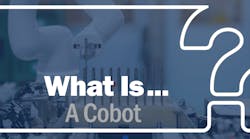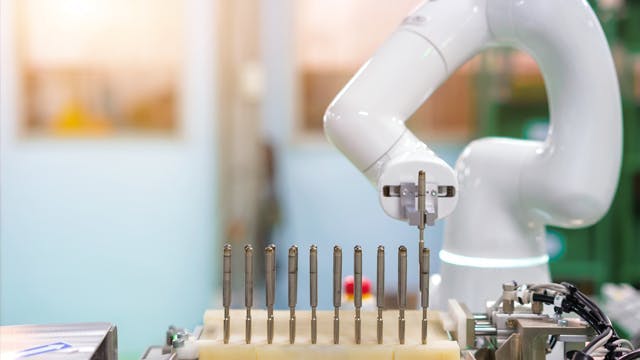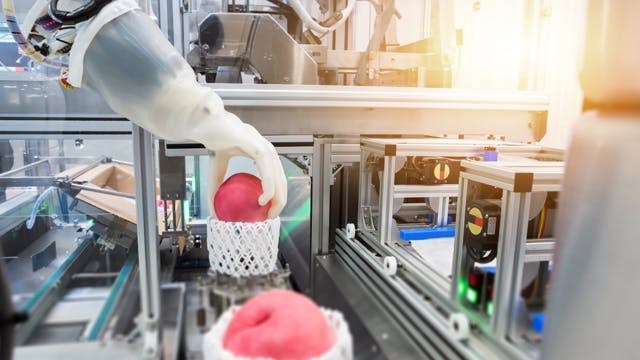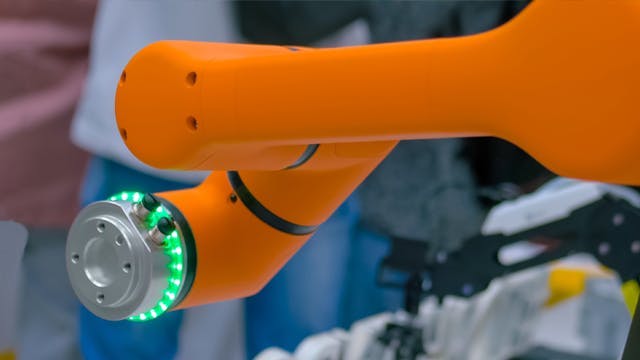Increasingly prevalent on the industrial floor, collaborative robot (cobot) technology has evolved to be a hero of efficiency and cost savings. This article offers guidance on whether cobots are right for your facility or application, and reviews some considerations for making smart decisions to achieve best results.
What is the difference between a robot and a cobot?
Industrial robots have been used in manufacturing settings for decades to automate tasks that require repetitive motion, moving heavy payloads, transferring objects at high speeds, or some combination of all three. By their very nature, they are unsafe to operate around people due to their heavy weight capacity and speed. For this reason, they are typically surrounded by a cage or some other form of guarding to prevent injuries and accidents.
Over the past fifteen years, a new kind of robot has been successfully introduced to the market – the cobot. Cobots are designed to work alongside humans. They can do this primarily because of their lower weight capacities and speeds. Equipped with sensors that detect objects, humans, and collisions, cobots immediately power down if they encounter anything unexpected in their paths. This avoids injuries to their human coworkers.
In addition to the speed, payload capacity, and safety differences, cobots are commonly much easier to program than their industrial robot counterparts. Many use a touchscreen interface that is intuitive even to workers without programming experience. Because of this, cobots can be easily reprogrammed to perform various tasks. In contrast, industrial robots typically require an expert to program, leading to a longer and more expensive deployment process. Also, they almost always perform a single task because the cost to move and reprogram them is significant. Cobots’ flexibility is a key feature that differentiates them from traditional robots.
What is a cobot used for?
The manufacturing applications suitable for a cobot are almost endless. One of the most popular applications is machine tending. A cobot can often tend to multiple machines at once and manage tasks that include loading and unloading parts, plus starting and stopping the machine cycle. This frees machine operators to work on higher-value tasks while reducing the monotony of their jobs.
Another common application is assembly. Cobots can perform precise assembly tasks like screw-driving, part-fitting and insertion. These highly repetitive and dull tasks are well-suited to a cobot’s skill set.
Material finishing tasks like polishing, sanding, and buffing are also popular cobot tasks. Because the cobots can apply a constant programmed force, they are often better suited to these jobs than their human counterparts.
Similarly, dispensing is something that a cobot excels at. Whether it is glue, sealant, or paint, a cobot can apply a consistent measure, improving accuracy and reducing waste.
What are the advantages and disadvantages of a cobot?
The main advantages of cobots are safety, flexibility, accuracy, improved productivity, and reduced expenses.
- Cobots increase safety. Collaborative robots can make a work environment safer in two ways. (1) Taking on hazardous jobs – cobots excel at performing dull, dirty and dangerous tasks, including welding, soldering, chemical work, and lifting heavy goods. Taking on these jobs allows human workers to perform tasks with less risk of injury or illness. (2) The previously mentioned sensors allow cobots to work around humans and prevent injuries from collisions. Working this way with an industrial robot is not possible.
- Cobots are flexible. Most are easily programmed via touchscreen. This means they can be programmed to do one task for a set amount of time and then reprogrammed and moved to perform a different task. This is great for smaller manufacturers who may not produce thousands of units on one machine. Even smaller batches can be automated with a cobot. That kind of flexibility is nonexistent with industrial robots, which are typically more difficult to program and immovable once in place.
- Cobots are accurate. They will use the same amount of force and move to the exact location required for the task in a highly repeatable way. This would challenge even the most skilled human workers. Manufacturers consistently find that error rates drop significantly after implementing cobots.
- Cobots improve productivity. Their ability to perform repetitive tasks without stopping produces more parts per shift. They can often be deployed to run without human intervention in a “lights-out” manufacturing environment.
- Cobots reduce production expenses. Costs are reduced by streamlining and optimizing production processes. The average payback period after purchasing a cobot and putting it into production is less than one year. The payback period for cobots producing goods 24 hours a day can be even shorter.
For all their benefits, cobots may not be the right choice for every application. Their top three limitations:
- Cobots have lower payloads. By nature, cobots must carry somewhat limited payloads compared to industrial robots. When working around humans, a collision involving a large payload can cause injuries, even at slower speeds. For this reason, a cobot’s payload capacity must be reduced.
- Cobots are slower. Similarly, a cobot cannot work as fast as an industrial robot. High-speed collisions are dangerous, so collaborative robots have safety features that limit their speed. They are not recommended for applications in which high speeds are required.
- Cobots have some safety considerations. Lastly, while cobots are safer than industrial robots, the risks cannot be completely ignored. Each application is different, and a safety assessment must still be done to ensure a secure working environment for employees. Adding a knife to the end of the cobot arm, for example, drastically changes the nature of the environment. This may require additional safety hardware and programming at an extra cost to the manufacturer.
Cobots can be very beneficial in the right environment, save costs and free employees to concentrate on other tasks. The continually improving technology makes them more practical than ever in the factories of the present and future.




